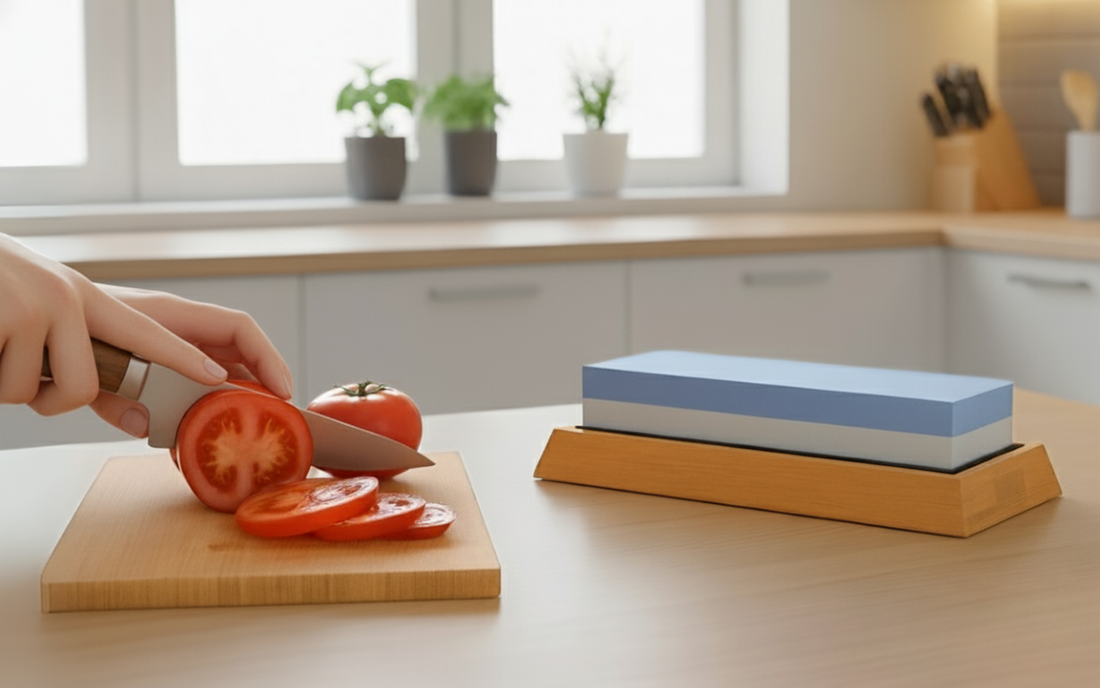A good knife is a must-have in any kitchen, whether you're a pro or just cooking for your family. If you want your knives to cut as smoothly as a razor and last for years, then you need to learn how to sharpen them on whetstones. It's not just the best way to cut, it's also the most satisfying. You'll have full control of the process and end up with a perfectly smooth cutting edge every time.
Sharpening kitchen knives is a great way to restore their sharpness and keep your tools in top condition for years. One of the most popular ways to keep your blade sharp is with a water stone, which is used by both professional chefs and home cooking enthusiasts. If you do it right, you'll end up with a blade that's as smooth, precise and durable as can be.
Why should you use water stones?
Sharpening with whetstones is a great technique that gives you total control over the process. Unlike automatic sharpeners, a stone lets you decide for yourself on the angle, pressure and speed of work. This restores the knife to its original sharpness and makes sure that its structure and shape stay intact for years to come.
A whetstone is also really gentle on the blade — the water cools the metal, removes impurities and makes it slide, which means it's less likely to overheat the steel. The result is an edge that is both sharp and 'soft' to use, allowing you to cut with sensitivity and without jerking. A knife that's been sharpened on a stone is a whole different experience: quieter, smoother and more precise.
Another big plus of this method is how flexible it is. You can use the same stone for kitchen knives, Japanese knives, butcher knives or utility knives — just choose the right grain size. Low-grade stones (400–1000) are great for repairing heavily blunt blades, medium-grade stones (1000–3000) are for regular sharpening, and high-grade stones (3000–8000) are for final smoothing and polishing. The result? This knife is really precise and stays sharp for longer.

Preparing for sharpening
Before you start, it's a good idea to get your workstation and tools ready. This is the secret to comfort, safety and consistent results.
1. Choosing a stone
The first step is picking the right stone. In our collection, you'll find stones with different grit sizes: 400/1000, 1000/3000, 1000/4000 and 3000/8000. The lower the number, the more aggressive the abrasion; the higher the number, the more delicate and precise the finish. If you're just starting out, a 1000/3000 whetstone is perfect, as it can be used for both sharpening and polishing.
2. Soaking the stone
Just make sure you give the water stone a good soak in clean water for a few minutes, until the air bubbles stop coming out. Just make sure you keep its surface moist while you're sharpening it so that the blade moves smoothly and the abrasion is even.
3. Stable position
The stone should be stable – best on a special stand or a wet towel. Having good lighting and being comfortable will make sure you're both comfortable and precise, and safe too.
Sharpening technique step by step
Step 1: Set the angle.
For most kitchen knives, the best sharpening angle is around 15–20°. This is a compromise between sharpness and edge durability. The key is to keep the same angle throughout, because that'll give you a nice, even blade line.
Step 2: Sharpen one side.
Pop the knife on the stone and move it smoothly from heel to tip, guiding the blade along its entire length in a slightly diagonal motion. Don't press too hard — the work should be calm, rhythmic, almost meditative. After a few goes, you'll see a fine suspension of metal and water, which is a sign that the sharpening is going well.
Step 3: Sharpen the other side.
Turn the knife over and do the same number of strokes on the other side. This'll give you a symmetrical edge and even sharpness. It's a good idea to rinse the stone and knife every few strokes to get rid of any bits that have got stuck.
Step 4: Polishing
Then, use a stoned with a higher grit (like 3000–8000) to polish the blade and make it nice and smooth. You can also use a leather strop to polish the blade and make a few strokes to remove microscopic burrs. The result? The blade is razor-sharp, so you can get thin slices of tomato or delicate herbs.
Good practices and care
- Make sure you keep the pressure even – too much pressure can damage the edge or create unevenness.
- Make sure you sharpen the whole blade, from the base to the tip, to avoid any dead areas.
- Take care of the stone – after sharpening, just wash it with water, dry it and store it somewhere dry. Just check it every now and then to make sure it's flat – if it isn't, level it off.
- It's better to sharpen more often, but not for long, than to do it rarely and for a long time. This'll keep the edge in perfect condition and reduce material wear.
How often should you sharpen your knives?
It depends how often you use them. When you're using a knife in a home kitchen, sharpening every few months is enough. If you're a pro, you'll sharpen your knife every week. It's important to keep an eye on how it's behaving: if it's not cutting smoothly, you know it's time to get the whetstone out.
Summary
Sharpening kitchen knives on water stones is a bit of an art, but it's really satisfying when you get the hang of it. It's a mix of precision, intuition and ritual. If you take care of your blades regularly, they'll keep running smoothly and safely for years, and you'll enjoy cooking even more.

